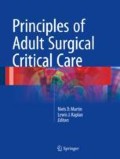Abstract
The nurse practitioner (NP) and physician assistant (PA) professions began in the 1960s in response to shortages of primary care providers [1]. However, NP and PA roles have expanded over the years to meet patient care needs in specialty and subspecialty areas of practice. Nationally, a growing number of intensive care units (ICUs) are integrating the use of advanced practice providers (APPs) including NPs and PAs as a strategy for meeting ICU workforce needs [2, 3]. Currently, more than 205,000 NPs and more than 93,000 PAs are practicing in the United States [4, 5]. NPs and PAs play an increasing role on ICU teams to assist in direct patient care management in conjunction with the intensivist led team along with other role components including leading quality improvement initiatives, assisting with research studies, and promoting continuity of care in the ICU [5–7]. According to the 2013 AAPA Annual Survey Report (15,025 respondents), 2.3 % of the PA respondents listed the ICU as their primary clinical work setting.
References
Ford LC. Reflections on 50 years of change. J Nurse Pract. 2015;27:294–5.
Pastores SM, O’Connor MF, Kleinpell RM, et al. The ACGME resident duty-hour new standards: history, changes, and impact on staffing of intensive care units. Crit Care Med. 2012;39:2540–9.
Ward N, Afessa B, Kleinpell R, et al. Intensivist/patient ratios in closed ICUs: a statement from the society of critical care medicine taskforce on ICU staffing. Crit Care Med. 2013;41:638–45.
American Association of Nurse Practitioners (AANP). Nurse Practitioner Fact Sheet. http://www.aanp.org/all-about-nps/np-fact-sheet. Accessed 20 June 2015.
American Academy of Physician Assistants (AAPA). What is a physician assistant? https://www.aapa.org. Accessed 20 June 2015.
American Academy of Physician Assistants (AAPA). Physician assistants in the ICU: a Critical Presence. https://www.aapa.org. Accessed 29 June 2015.
American Nurses Credentialing Center. 2013 certification data report. Silver Spring: American Nurses Credentialing Center; 2014.
Kleinpell R. Acute care nurse practitioner practice: results of a 5 year longitudinal study. Am J Crit Care. 2005;14:211–9.
Kleinpell R, Buchman T, Boyle WA (editors). Integrating nurse practitioners and physician assistants in the ICU: strategies for optimizing contributions to care. Society of Critical Care Medicine. Chicago Illinois. 2012.
Moote M, Krsek C, Kleinpell R, et al. Physician assistant and nurse practitioner utilization in academic medical centers. Am J Med Qual. 2011;5:1–9.
Kleinpell RM, Ely EW, Grabenkort R. Nurse practitioners and physician assistants in the ICU: an evidence based review. Crit Care Med. 2008;26:2888–97.
Gracias VH, Sicoutris CP, Stawicki SP, et al. Critical care nurse practitioners improve compliance with clinical practice guidelines in “semiclosed” surgical intensive care unit. J Nurs Care Qual. 2008;23:338–44.
Gillard JN, Szoke A, et al. Utilization of PAs and NPs at a level 1 trauma center: effects on outcomes. JAAPA. 2011;24(7):34, 40–3.
Meyer SC, Miers LJ. Cardiovascular surgeon and acute care nurse practitioner: collaboration on postoperative outcomes. AACN Clin Issues. 2005;16:149–58.
Russell D, VorderBruegge M, Burns SM. Effect of an outcomes-managed approach to care of neuroscience patients by acute care nurse practitioners. Am J Crit Care. 2002;11:353–62.
Edkins RE, Cairns BA, et al. A systematic review of APPs in acute care: options for a new model in a burn ICU. Ann Plast Surg. 2014;72(3):285–8.
McMillan MA, Boucher N, Keith D, et al. Maintaining quality of care 24/7 in a nontrauma surgical intensive care unit. J Trauma Acute Care Surg. 2012;73:202–8.
Sise CB, Sise JM, Kelley DM, et al. Resource commitment to improve outcomes and increase value at a level 2 trauma center. J Trauma Inj Infect Crit Care. 2011;70:560–8.
Kapu AN, Wheeler AP, Lee B. Addition of acute care nurse practitioners to medical and surgical rapid response: a pilot program. Crit Care Nurse. 2014;34:51–9.
Kapu AN, Kleinpell R, Pilon B. Quality and financial impact of adding nurse practitioners to inpatient care teams. J Nurs Adm. 2014;44:87–96.
Costa DK, Wallace DT, et al. NP/PA staffing and critical care mortality. Chest. 2014;146(6):1566–73.
Grabenkort WR, Kopan K, Mollenkopf FP, Keith DE. Developing orientation programs for nurse practitioners and physician assistants in the ICU. In: Integrating Nurse Practitioners & Physician Assistants into the ICU. Mount Prospect: Society of Critical Care Medicine; 2012. p. 48–64.
Luckianow GM, Piper GL, Kaplan LJ. Bridging the gap between training and advanced practice provider critical care competency. JAAPA. 2015;28(5):1–5 (surgical ICUs).
Paton A, Stein D, D’Agostino R, Pastores S, Halpern NA. Critical care medicine advanced practice provider model at a comprehensive cancer center: successes and challenges. Am J Crit Care. 2013;22:439–43.
Kapu AN, Thomson-Smith C, Jones P. NPs in the ICU: the Vanderbilt initiative. Nurse Pract. 2012;10(37):46–52.
http://www.emoryhealthcare.org/critical-care, http://carolinashealthcare.org/center-for-advanced-practice.
Kleinpell R, Ward NS, Kelso LA, et al. Provider to patient ratios for nurse practitioners and physician assistants in critical care units. Am J Crit Care. 2015;24:e16–21.
Kleinpell R, Ely W, Williams G, et al. Concise review: web-based resources for critical care education. Crit Care Med. 2011;39:541–53.
Kleinpell R, Boyle WA, Buchman T, editors. Meeting 21st-century challenges in critical care delivery and beyond: nurse practitioner and physician assistant providers in the ICU. In: Integrating nurse practitioners and physician assistants in the ICU: strategies for optimizing contributions to care. Mount Prospect: Society of Critical Care Medicine. Chicago Illinois. 2012. p. 1–8.
Author information
Authors and Affiliations
Corresponding author
Editor information
Editors and Affiliations
Rights and permissions
Copyright information
© 2016 Springer International Publishing Switzerland
About this chapter
Cite this chapter
Kleinpell, R., Grabenkort, W.R. (2016). Incorporating Advanced Practice Practitioners in the ICU. In: Martin, N.D., Kaplan, L.J. (eds) Principles of Adult Surgical Critical Care. Springer, Cham. https://doi.org/10.1007/978-3-319-33341-0_48
Download citation
DOI: https://doi.org/10.1007/978-3-319-33341-0_48
Published:
Publisher Name: Springer, Cham
Print ISBN: 978-3-319-33339-7
Online ISBN: 978-3-319-33341-0
eBook Packages: MedicineMedicine (R0)

